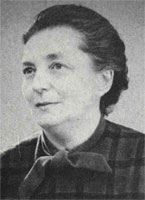
 Germaine Montereau, born on December 31, 1892, in Sully-sur-Loire, did not attend any art school. In Paris, she lived among antique dealers, familiarized herself with art objects from various origins, and regularly visited museums.
Germaine Montereau, born on December 31, 1892, in Sully-sur-Loire, did not attend any art school. In Paris, she lived among antique dealers, familiarized herself with art objects from various origins, and regularly visited museums.
In 1917, an accident forced her to move to Berck, where she stayed for five years. During this time, she immersed herself in the study of art books and cultivated an exceptional culture. Once recovered, she lived in the countryside and drew. One day she embroidered a flower, which decided her vocation. In 1924, Paul Rodocanachi saw her trials and commissioned her to garnish Louis XVI furniture. Inspired by ancient techniques, she created exquisite needle-embroidered velvet embroidery. She then began to work for him, Arturo Lopez, and foreign buyers.
She trained embroiderers and organized her workshops in Beaugency. In 1925, American painter A.B. Davies entrusted her with executing tapestries. She learned the craft from a Gobelins artisan and embarked on a rich collaboration with Davies, full of various inventions, which lasted until his death. She then directed her research into her own domain: hand weaving. In 1932, her first exhibition took place. Louis Chéronnet and Albert Lévy discovered her and asked her to exhibit in their gallery on rue de l'Echelle in 1933 and 1934. She exhibited at Rouard in 1935, set up Dr. Payot's beauty institute, and participated in an exhibition in Milan in 1936.
From 1932 to 1936, she collaborated with decorators J.M. Frank, Paul Bry, Gascoin, Sognot, worked for Daniel Rops, François Mauriac, Dr. Hemmerdinger, created "The Metamorphoses" tapestries with Jean Hugo for Emilio Terry and for Hermès, and gave free rein to her imagination. At the end of 1936, she left for Morocco and returned to weaving. She trained local artisans and decorated opulent private residences and high-end stores, first in Mogador and then in Casablanca.
During the war, using cotton spun by locals, she made beautiful clothing fabrics. She returned to Beaugency in 1946 and held her last exhibition at "la Crémaillère" in 1947. After this, due to health reasons, she had to give up all work and creation. Despite Germaine Montereau's activity barely lasting more than twenty years and with the most significant part of her production abroad or in Morocco, her personality, taste, and technical innovations have left a mark on the art of weaving in our time. She was the first to dare to make entirely white floor rugs and fabrics, she rehabilitated the splendor of China reds and launched tomato tones. Inspired by ancient masterpieces, she created the most modern fabrics using sumptuous fancy silk threads from China or fine metal, beautiful natural fibers, and also the most rustic ones – aloe, rabane – and artificial fibers. She wove the first egret silks, cellophane, and lacquered strings invented by Kuhlmann.
Chéronnet could affirm that she had woven everything and she made thousands of samples that one would have liked to see in the Lyon textile museum. She made perforated cotton or shiny rayon window hangings but was primarily an indefatigable creator in the art of rug making. Rugs knotted with dense, finely carved wool, or long, soft, fluffy locks like fleece. If, at the time of her high foreign vogue, she indulged in all sorts of inventions - created wool mosaics in the Coptic manner and conceived rugs in reliefs of three or four layers on a tapestry background - what we know of her work has a more austere beauty, even in its preciousness.
She no longer required the aid of any decor. The virtue of the material, highlighted by the infinite variety of her stitches, by the most unexpected encounters, pure color harmonies, gives her weavings an opulent rustic character.
Despite her culture and travels, Germaine Montereau remained typically – in spirit as well as physically – attached to the "Loire Valley," inheriting its artisanal and earthy tradition.
Sources : Mobilier et Decoration N° 5 Juin 1954